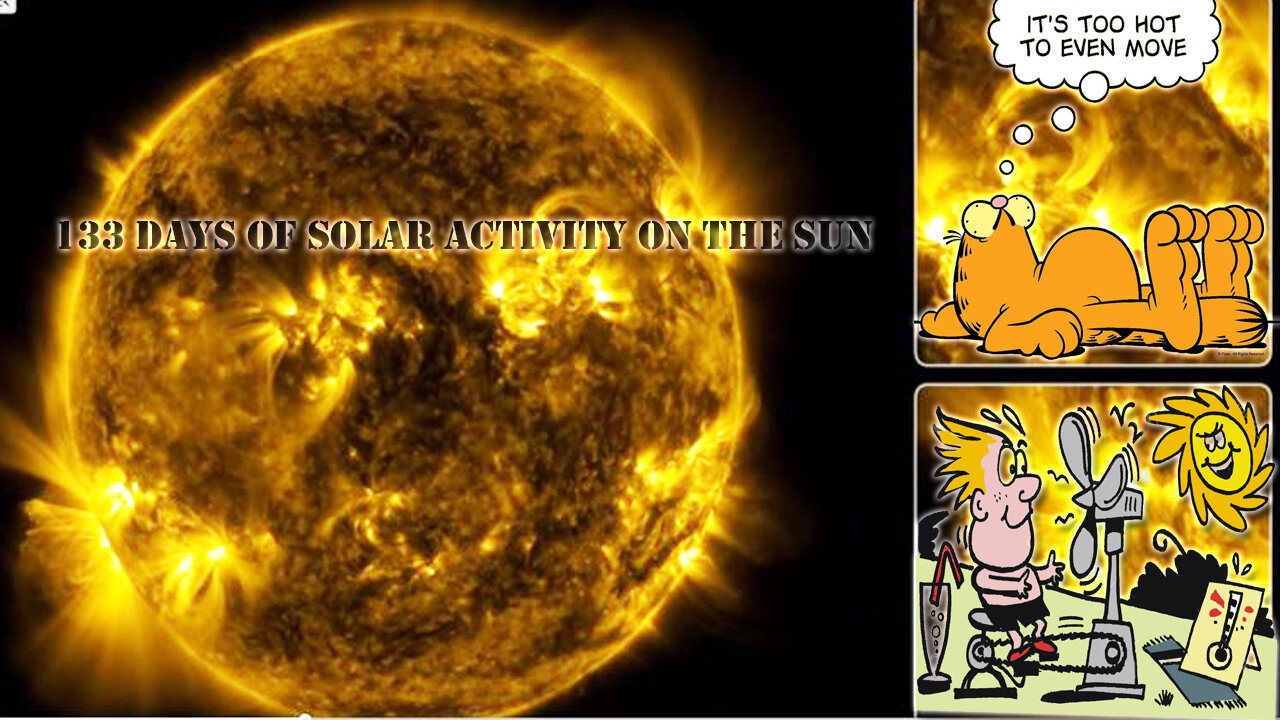Premium Only Content

133 Days of Solar Activity on the Sun
This video documents the sequence of solar events spanning from August 12 to December 22, 2022, as captured by NASA's Solar Dynamics Observatory (SDO). Positioned in orbit around Earth, the SDO has consistently captured high-resolution images of the Sun for nearly 13 years. This dataset has yielded countless insights into the Sun's behavior, its impact on the solar system, and has led to a multitude of discoveries.
Equipped with a trio of instruments, the SDO captures an image of the Sun every 0.75 seconds. The Atmospheric Imaging Assembly (AIA) instrument, in particular, captures images every 12 seconds across ten distinct wavelengths of light. The presented time-lapse, spanning 133 days, focuses on images taken at a wavelength of 17.1 nanometers, highlighting the Sun's outermost atmospheric layer known as the corona. Condensing 133 days, equivalent to about four months, of solar observations into a 59-minute video, this presentation showcases the Sun's dynamic activity as it rotates.
Active regions of brightness traverse the Sun's surface, driven by its roughly 27-day rotation period. The video exhibits magnetic fields extending above these luminous areas, entrapping scorching, luminous plasma. These brilliant regions are also the sources of solar flares—intense bursts of light resulting from the rapid merging of magnetic fields, known as magnetic reconnection.
While the SDO has been vigilantly observing the Sun, a few instances have eluded its gaze. Dark frames within the video stem from the Earth or the Moon momentarily eclipsing the SDO during their passage between the spacecraft and the Sun. Additional blackouts may arise due to instrument downtime or data discrepancies. The SDO transmits a staggering 1.4 terabytes of data to the ground each day.
Noteworthy images where the Sun appears off-center correspond to moments when the SDO's instruments were being calibrated. Looking ahead, both the SDO and other NASA missions will continue monitoring the Sun, contributing further insights into our cosmic environment and offering essential information to ensure the safety of astronauts and assets.
The accompanying music is a seamless compilation from Lars Leonhard's "Geometric Shapes" album, courtesy of the artist.
Credit for this video goes to NASA's Goddard Space Flight Center, with Scott Wiessinger serving as Lead Producer, Tom Bridgman as Lead Visualizer, and Scott Wiessinger also taking on the role of Editor. You are encouraged to freely share and download this video at [link provided]. While the video itself can be shared without seeking permission, certain musical components and individual imagery may necessitate permission for reuse or remixing. Detailed information about such components can be found at [link provided]. For additional information on NASA's media guidelines, please visit [provided link].
**Video Description:**
The video's left side portrays the complete circular view of the Sun. Its hue is golden yellow, marked by patches and thin wisps extending from the surface. Variations in brightness are evident, ranging from intensely bright to nearly black. The Sun rotates steadily, completing one full rotation in a 12-minute interval as observed in this time-lapse. Typically, a few bright regions are visible at any given time, flickering and shifting akin to small fires. From these regions, delicate loops extend above the surface, their shapes and sizes dynamically altering. The video's right side features two outlined squares that provide enlarged views of captivating sections of the Sun.
-
 1:05:28
1:05:28
Flyover Conservatives
22 hours agoUkraine’s Dirty Secret: The Christian Persecution No One Wants to Talk About - Alex Newman | FOC Show
52.7K19 -
 2:00:20
2:00:20
Glenn Greenwald
14 hours agoThe View from Moscow: Key Russian Analyst Aleksandr Dugin on Trump, Ukraine, Russia, and Globalism | SYSTEM UPDATE #414
131K57 -
 1:10:55
1:10:55
Donald Trump Jr.
12 hours agoBREAKING NEWS: My Father Revokes Biden-Maduro Oil License, LIVE with Maria Corina Machado | Triggered Ep.220
203K196 -
 1:25:29
1:25:29
Sarah Westall
10 hours agoX-Files True History, Project Blue Beam, Cabal Faction War w/ Former FBI Agent John DeSouza
84.5K16 -
 7:03:49
7:03:49
Dr Disrespect
17 hours ago🔴LIVE - DR DISRESPECT - NEW PC VS. DELTA FORCE - MAX SETTINGS
170K27 -
 49:04
49:04
Lights, Camera, Barstool
1 day agoIs The Monkey The Worst Movie Of The Year?? + Amazon Gets Bond
75.1K4 -
 24:19
24:19
Adam Carolla
1 day agoDiddy’s Legal Drama Escalates, Smuggler Caught Hiding WHAT? + Philly Eagles & The White House #news
135K20 -
 10:12
10:12
Mike Rowe
2 days agoClint Hill: What A Man. What A Life. | The Way I Heard It with Mike Rowe
130K17 -
 1:31:52
1:31:52
Redacted News
13 hours agoBOMBSHELL! This is war! FBI whistleblowers reveal Epstein files being destroyed? | Redacted News
199K383 -
 48:55
48:55
Candace Show Podcast
13 hours agoSTOP EVERYTHING. They FINALLY Mentioned ME In The Blake Lively Lawsuit! | Candace Ep 152
171K134